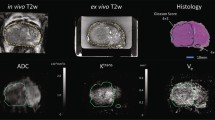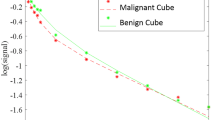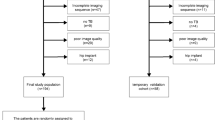Abstract
Objectives
The objectives are determine the optimal combination of MR parameters for discriminating tumour within the prostate using linear discriminant analysis (LDA) and to compare model accuracy with that of an experienced radiologist.
Methods
Multiparameter MRIs in 24 patients before prostatectomy were acquired. Tumour outlines from whole-mount histology, T2-defined peripheral zone (PZ), and central gland (CG) were superimposed onto slice-matched parametric maps. T2, Apparent Diffusion Coefficient, initial area under the gadolinium curve, vascular parameters (Ktrans,Kep,Ve), and (choline+polyamines+creatine)/citrate were compared between tumour and non-tumour tissues. Receiver operating characteristic (ROC) curves determined sensitivity and specificity at spectroscopic voxel resolution and per lesion, and LDA determined the optimal multiparametric model for identifying tumours. Accuracy was compared with an expert observer.
Results
Tumours were significantly different from PZ and CG for all parameters (all p < 0.001). Area under the ROC curve for discriminating tumour from non-tumour was significantly greater (p < 0.001) for the multiparametric model than for individual parameters; at 90 % specificity, sensitivity was 41 % (MRSI voxel resolution) and 59 % per lesion. At this specificity, an expert observer achieved 28 % and 49 % sensitivity, respectively.
Conclusion
The model was more accurate when parameters from all techniques were included and performed better than an expert observer evaluating these data.
Key Points
• The combined model increases diagnostic accuracy in prostate cancer compared with individual parameters
• The optimal combined model includes parameters from diffusion, spectroscopy, perfusion, and anatominal MRI
• The computed model improves tumour detection compared to an expert viewing parametric maps




Similar content being viewed by others
Abbreviations
- ADC:
-
Apparent Diffusion Coefficient
- CG:
-
Central Gland
- DCE-MRI:
-
Dynamic Contrast-Enhanced MRI
- DWI:
-
Diffusion Weighted Imaging
- PZ:
-
Peripheral Zone
- T2W:
-
T2-weighted
- MRSI:
-
Magnetic Resonance Spectroscopic Imaging
- LDA:
-
Linear Discriminant Analysis
- IAUGC:
-
Initial Area Under Gadolinium Curve
References
Roethke MC, Kniess M, Kaufmann S et al (2014) Can high-spatial resolution T2-weighted endorectal MRI rule out clinically significant prostate cancer? World J Urol 32:379–383
Yamamura J, Salomon G, Buchert R et al (2011) Magnetic resonance imaging of prostate cancer: diffusion-weighted imaging in comparison with sextant biopsy. J Comput Assist Tomogr 35:223–228
Nagayama M, Watanabe Y, Terai A et al (2011) Determination of the cutoff level of apparent diffusion coefficient values for detection of prostate cancer. Jpn J Radiol 29:488–494
Mazaheri Y, Hricak H, Fine SW et al (2009) Prostate tumor volume measurement with combined T2-weighted imaging and diffusion-weighted MR: correlation with pathologic tumor volume. Radiology 252:449–457
Langer DL, van der Kwast TH, Evans AJ et al (2009) Prostate cancer detection with multi-parametric MRI: Logistic regression analysis of quantitative T2, diffusion-weighted imaging, and dynamic contrast-enhanced MRI. J Magn Reson Imaging 30:327–334
Bittencourt LK, Barentsz JO, de Miranda LC, Gasparetto EL (2012) Prostate MRI: diffusion-weighted imaging at 1.5T correlates better with prostatectomy Gleason Grades than TRUS-guided biopsies in peripheral zone tumours. Eur Radiol 22:468–475
Oto A, Yang C, Kayhan A et al (2011) Diffusion-weighted and dynamic contrast-enhanced MRI of prostate cancer: correlation of quantitative MR parameters with Gleason score and tumor angiogenesis. AJR Am J Roentgenol 197:1382–1390
Langer DL, van der Kwast TH, Evans AJ et al (2010) Prostate tissue composition and MR measurements: investigating the relationships between ADC, T2, K(trans), v(e), and corresponding histologic features. Radiology 255:485–494
Jackson AS, Reinsberg SA, Sohaib SA et al (2009) Dynamic contrast-enhanced MRI for prostate cancer localization. Br J Radiol 82:148–156
Franiel T, Hamm B, Hricak H (2011) Dynamic contrast-enhanced magnetic resonance imaging and pharmacokinetic models in prostate cancer. Eur Radiol 21:616–626
Yamamura J, Salomon G, Buchert R et al (2011) MR imaging of prostate cancer: diffusion weighted imaging and (3D) hydrogen 1 (H) MR spectroscopy in comparison with histology. Radiol Res Pract 2011:616852
Reinsberg SA, Payne GS, Riches SF et al (2007) Combined use of diffusion-weighted MRI and 1H MR spectroscopy to increase accuracy in prostate cancer detection. AJR Am J Roentgenol 188:91–98
Weinreb JC, Blume JD, Coakley FV et al (2009) Prostate cancer: sextant localization at MR imaging and MR spectroscopic imaging before prostatectomy–results of ACRIN prospective multi-institutional clinicopathologic study. Radiology 251:122–133
Scheenen TW, Futterer J, Weiland E et al (2011) Discriminating cancer from noncancer tissue in the prostate by 3-dimensional proton magnetic resonance spectroscopic imaging: a prospective multicenter validation study. Investig Radiol 46:25–33
Garcia-Martin ML, Adrados M, Ortega MP et al (2011) Quantitative (1) H MR spectroscopic imaging of the prostate gland using LCModel and a dedicated basis-set: correlation with histologic findings. Magn Reson Med 65:329–339
Turkbey B, Pinto PA, Mani H et al (2010) Prostate cancer: value of multiparametric MR imaging at 3 T for detection–histopathologic correlation. Radiology 255:89–99
Kumar V, Jagannathan NR, Kumar R et al (2006) Correlation between metabolite ratios and ADC values of prostate in men with increased PSA level. Magn Reson Imaging 24:541–548
Groenendaal G, Borren A, Moman MR et al (2012) Pathologic validation of a model based on diffusion-weighted imaging and dynamic contrast-enhanced magnetic resonance imaging for tumor delineation in the prostate peripheral zone. Int J Radiat Oncol Biol Phys 82:e537–e544
Futterer JJ, Heijmink SW, Scheenen TW et al (2006) Prostate cancer localization with dynamic contrast-enhanced MR imaging and proton MR spectroscopic imaging. Radiology 241:449–458
de Rooij M, Hamoen EH, Futterer JJ, Barentsz JO, Rovers MM (2014) Accuracy of multiparametric MRI for prostate cancer detection: a meta-analysis. AJR Am J Roentgenol 202:343–351
Borren A, Groenendaal G, Moman MR et al (2014) Accurate prostate tumour detection with multiparametric magnetic resonance imaging: dependence on histological properties. Acta Oncol 53:88–95
Riches SF, Payne GS, Morgan VA et al (2009) MRI in the detection of prostate cancer: combined apparent diffusion coefficient, metabolite ratio, and vascular parameters. AJR Am J Roentgenol 193:1583–1591
Altman DG (1990) Practical Statistics for Medical Research. Taylor & Francis.
d’Arcy JA, Collins DJ, Padhani AR et al (2006) Magnetic Resonance Imaging Workbench: analysis and visualization of dynamic contrast-enhanced MR imaging data. Radiographics 26:621–632
Orton MR, d'Arcy JA, Walker-Samuel S et al (2008) Computationally efficient vascular input function models for quantitative kinetic modelling using DCE-MRI. Phys Med Biol 53:1225–1239
Parker GJ, Roberts C, Macdonald A et al (2006) Experimentally-derived functional form for a population-averaged high-temporal-resolution arterial input function for dynamic contrast-enhanced MRI. Magn Reson Med 56:993–1000
Rohrer M, Bauer H, Mintorovitch J, Requardt M, Weinmann HJ (2005) Comparison of magnetic properties of MRI contrast media solutions at different magnetic field strengths. Investig Radiol 40:715–724
Provencher SW (2001) Automatic quantitation of localized in vivo 1H spectra with LCModel. NMR Biomed 14:260–264
Jhavar SG, Fisher C, Jackson A et al (2005) Processing of radical prostatectomy specimens for correlation of data from histopathological, molecular biological, and radiological studies: a new whole organ technique. J Clin Pathol 58:504–508
Barentsz JO, Richenberg J, Clements R et al (2012) ESUR prostate MR guidelines 2012. Eur Radiol 22:746–757
Selnaes KM, Heerschap A, Jensen LR et al (2012) Peripheral zone prostate cancer localization by multiparametric magnetic resonance at 3 T: unbiased cancer identification by matching to histopathology. Investig Radiol 47:624–633
Shah V, Turkbey B, Mani H et al (2012) Decision support system for localizing prostate cancer based on multiparametric magnetic resonance imaging. Med Phys 39:4093–4103
Wefer AE, Hricak H, Vigneron DB et al (2000) Sextant localization of prostate cancer: comparison of sextant biopsy, magnetic resonance imaging and magnetic resonance spectroscopic imaging with step section histology. J Urol 164:400–404
Mazaheri Y, Shukla-Dave A, Hricak H et al (2008) Prostate cancer: identification with combined diffusion-weighted MR imaging and 3D 1H MR spectroscopic imaging–correlation with pathologic findings. Radiology 246:480–488
Le Nobin J, Orczyk C, Deng FM et al (2014) Prostate Tumor Volumes: Agreement Between MRI and Histology Using Novel Co-registration Software. BJU Int.
Reisaeter LA, Futterer JJ, Halvorsen OJ et al (2014) 1.5-T multiparametric MRI using PI-RADS: a region by region analysis to localize the index-tumor of prostate cancer in patients undergoing prostatectomy. Acta Radiol.
Engelbrecht MR, Huisman HJ, Laheij RJ et al (2003) Discrimination of prostate cancer from normal peripheral zone and central gland tissue by using dynamic contrast-enhanced MR imaging. Radiology 229:248–254
Padhani AR, Gapinski CJ, Macvicar DA et al (2000) Dynamic contrast enhanced MRI of prostate cancer: correlation with morphology and tumour stage, histological grade and PSA. Clin Radiol 55:99–109
Noworolski SM, Vigneron DB, Chen AP, Kurhanewicz J (2008) Dynamic contrast-enhanced MRI and MR diffusion imaging to distinguish between glandular and stromal prostatic tissues. Magn Reson Imaging 26:1071–1080
Kozlowski P, Chang SD, Jones EC et al (2006) Combined diffusion-weighted and dynamic contrast-enhanced MRI for prostate cancer diagnosis–correlation with biopsy and histopathology. J Magn Reson Imaging 24:108–113
Acknowledgments
The scientific guarantor of this publication is Prof Nandita deSouza. The authors of this manuscript declare no relationships with any companies, whose products or services may be related to the subject matter of the article. This study has received funding for the CRUK & EPSRC Cancer Imaging Centre in association with MRC and Dept of Health C1060/A10334 & NHS funding to the NIHR Biomedical Research Centre and the Clinical Research Facility in Imaging. Sophie Riches was funded by a Personal Award Scheme Researcher Developer Award from the National Institute for Health Research. Scott Morgan was funded by a research fellowship from the Canadian Association of Radiation Oncology and Elekta AB. One of the authors has significant statistical expertise. Institutional Review Board approval was obtained. Written informed consent was obtained from all subjects (patients) in this study. Methodology: Prospective, diagnostic or prognostic study, performed at one institution.
Author information
Authors and Affiliations
Corresponding author
Rights and permissions
About this article
Cite this article
Riches, S.F., Payne, G.S., Morgan, V.A. et al. Multivariate modelling of prostate cancer combining magnetic resonance derived T2, diffusion, dynamic contrast-enhanced and spectroscopic parameters. Eur Radiol 25, 1247–1256 (2015). https://doi.org/10.1007/s00330-014-3479-0
Received:
Revised:
Accepted:
Published:
Issue Date:
DOI: https://doi.org/10.1007/s00330-014-3479-0




